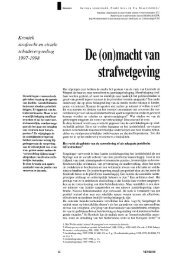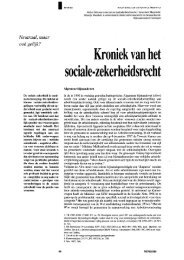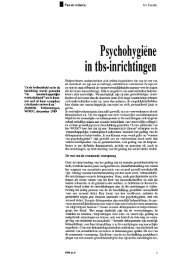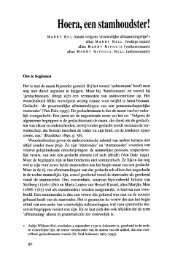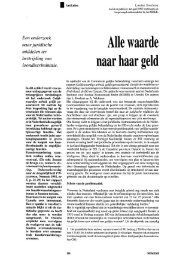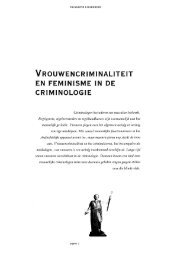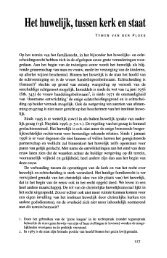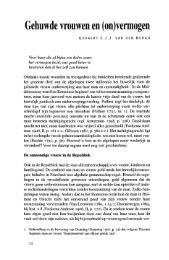(2003) nummer 3 mei/juni - Nemesis
(2003) nummer 3 mei/juni - Nemesis
(2003) nummer 3 mei/juni - Nemesis
You also want an ePaper? Increase the reach of your titles
YUMPU automatically turns print PDFs into web optimized ePapers that Google loves.
II Some headlines of the discussions<br />
During the discussions the participants<br />
of the expert meeting reached a consensus<br />
on a number of conceptual and legal<br />
issues concerning the nature of the<br />
provision at stake. Though quite abstract<br />
and general, these issues should<br />
be clarified in the GR.<br />
1. The meeting agreed that the GR<br />
should evaluate the scope and meaning<br />
of Article 4(1) with regard to the overall<br />
objectives and purposes of the Convention.<br />
(See below, paragraph IV.)<br />
2. There was a common understanding<br />
that although an obligation exists for<br />
States to adopt and apply TSMs, this<br />
obligation does not stem from article<br />
4(1) as an isolated provision, but flows<br />
from the combined Articles 1-5 and 24,<br />
read together as the general interpretative<br />
framework of the Convention. The<br />
mandatory character of TSMs also appears<br />
from the wording of the other<br />
(substantive) Articles (6-16) in which<br />
States are required to ('shall') take all<br />
appropriate measures in certain fields.<br />
3. From this perspective, Article 4(1)<br />
does not in itself impose a dufy on<br />
States to adopt and apply TSMs.<br />
Rather, it makes clear that if a State<br />
does take such measures, and if these<br />
measures fall within the terms of this<br />
provision, there can (by definition) be<br />
no complaint of discrimination raised<br />
by men. Thus, Article 4(1) is an explanation<br />
instead of an exception to the<br />
definition of discrimination.<br />
4. The importance of Article 4(1)<br />
should not be underestimated. It makes<br />
clear that 'accelerating de facto equality'<br />
of men and women is one of the<br />
goals of the Convention. As such, it<br />
contributes to the understanding that<br />
the concept of substantive equality is<br />
prevalent in the Convention. 4 Article<br />
4(1) contains a number of elements that<br />
need further clarification (see below,<br />
paragraph VI).<br />
5. The meeting further agreed that the<br />
GR should clearly distinguish between<br />
TSMs and 'general social policies'<br />
adopted and applied in order to im-<br />
' prove the position of both women and<br />
men. Not all measures that potentially<br />
or actually (mainly) improve the position<br />
of women qualify as TSMs. Providing<br />
favourable general conditions<br />
(ensured by the civil, political, social,<br />
economie and cultural human rights as<br />
such) for women and men that improves<br />
their situation can (nor should)<br />
not qualify as TSMs. Similarly measures<br />
that fall within the scope of article<br />
4(2) do not qualify as TSMs. (See<br />
also paragraph 11, below.)<br />
WETGEVING<br />
6. The following objectives of affirmative<br />
action programs, positive action<br />
plans, or TSMs were discussed in the<br />
meeting:<br />
- to remedy the effects of past or present<br />
discrimination against women and<br />
offer equal starting points or equal opportunitiés<br />
to women;<br />
- to accelerate the process of equal<br />
participation of women in all fields of<br />
social, economie, political and cultural<br />
life and the process of redistribution of<br />
power and resources and the bringing<br />
about of social and cultural change that<br />
will improve the de facto position of<br />
women;<br />
- to neutralise the advantages that<br />
men have in the existing social, economie,<br />
political and cultural systems.<br />
7. In its Preamble the CEDAW-Convention<br />
recognises the fact that women<br />
were and continue to be victims of<br />
discrimination. However, great dangers<br />
arise if one stresses past discrimination<br />
as the (only) justification<br />
for TSMs. This approach means that<br />
statistical evidence of under-representation<br />
of women should be presented<br />
and also some proof that this situation<br />
has indeed been caused by sex-discrimination.<br />
Proof of causation is particularly<br />
difficult to establish since many<br />
factors may play a role. In addition under<br />
this approach-one must establish<br />
that some (groups of) persons or institutions<br />
can be held responsible and<br />
should be obliged to offer an adequate<br />
repair.<br />
The fault-based idea of remedying<br />
(past) discrimination misses the point<br />
of the general obligation of the Convention,<br />
which is to eliminate discrimination<br />
and to improve the position of<br />
women by all appropriate means (including<br />
TSMs). Article 4(1) does not<br />
even speak of remedying past discrimination<br />
at all. Thus, the obligation to act<br />
on behalf of women exists irrespective<br />
of any proof of past or present discrimination.<br />
8. The second objective (to accelerate<br />
the process of equal participation of<br />
women, et cetera) takes as its starting<br />
point the present situation of women.<br />
From there, TSMs are seen as appropriate<br />
and necessary instruments to improve<br />
the position of women. This objective<br />
reflects more closely the<br />
wording of Article 4(1) itself. Additionally,<br />
this objective is more in line<br />
with recent changes in EC law where in<br />
Article 141(4) of the Treaty of Amsterdam<br />
the EC legislator uses the expression<br />
'(•••) with a view to ensuring full<br />
equality in practice' and also speaks of<br />
the 'underrepresented sex'. 5 In all the<br />
expert meeting suggests that the Committee<br />
stress the second objective in the<br />
GR and perhaps not mention the first<br />
one at all.<br />
9. The GR should point out that the<br />
problem to be addressed by way of<br />
TSMs is not the disadvantage that<br />
women suffer (through whatever<br />
cause), but rather the impact of the<br />
privileges that men have in existing social,<br />
economie, political and cultural<br />
structures. These advantages need to be<br />
neutralised by means of TSMs.<br />
10. However, TSMs may need 'extra'<br />
justification in certain cases where such<br />
measures (that are by definition directed<br />
exclusively at women) are held to<br />
be detrimental to fundamental rights<br />
of certain (individual) men. Only in<br />
such cases where there is a serious infringement<br />
of such a fundamental<br />
right, it is appropriate to examine<br />
whether the need for a TSM outweighs<br />
the individual right(s) of a man or<br />
group of men. In such cases one must<br />
determine whether the measure at stake<br />
does indeed qualify as a TSM, i.e.<br />
whether it serves the specific goal mentioned<br />
in Article 4(1) and whether the<br />
means chosen to reach this goal are appropriate<br />
and necessary to reach that<br />
goal.<br />
11. The GR should clarify the differences<br />
between Articles 4(1) and 4(2) of<br />
the Convention. The Country Reports<br />
indicate that States often confuse these<br />
two provisions. The main difference is<br />
that Article 4(2) applies to measures<br />
that are of ^.permanent nature. Another<br />
difference is that measures under Article<br />
4(2) are directed at specific biological<br />
differences between men and<br />
women with respect to their reproductive<br />
capacities.<br />
The GR should clarify that measures<br />
that fall within the scope of Article 4(2)<br />
should neither be seen as 'special'<br />
measures for women, nor as exceptions<br />
to the non-discrimination norm. Taking<br />
pregnancy and motherhood into<br />
consideration and ensuring rights to<br />
women on these grounds is simply a<br />
matter of doing justice to (biological)<br />
differences between the sexes. As such,<br />
this Article is an explanation of the<br />
concept of equality as embodied in the<br />
Convention, which comprises that<br />
there not only should be equal treatment<br />
of equals, but also that persons<br />
who are in different positions should be<br />
treated differently. This concept of<br />
equality requires that sociëties treat<br />
different biological interests, such as<br />
pregnancy and childbirth, in such a<br />
NEMESIS <strong>2003</strong> nr. 3 37



